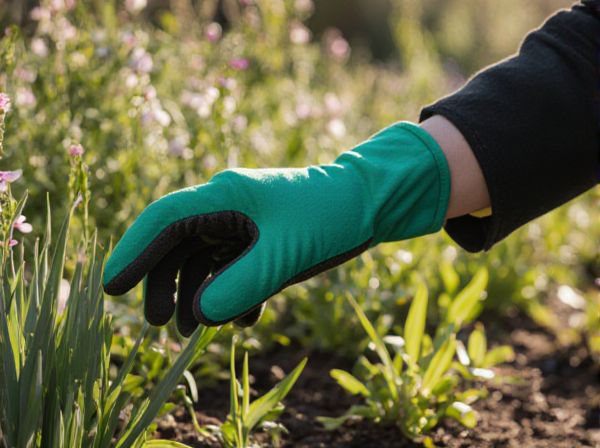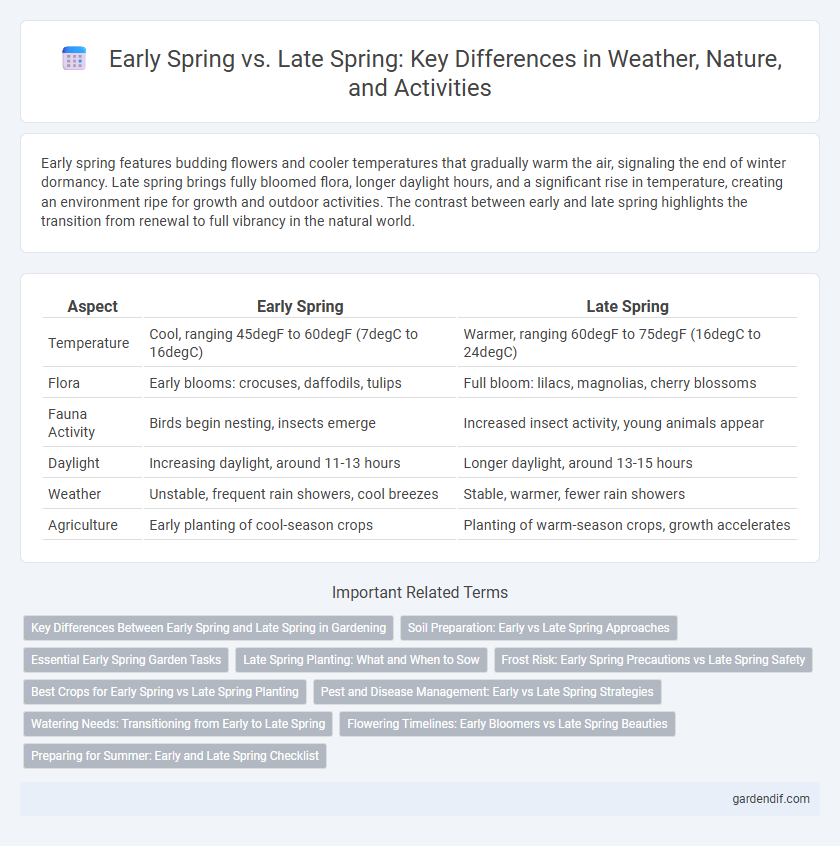
Early Spring vs Late Spring Illustration
Early spring features budding flowers and cooler temperatures that gradually warm the air, signaling the end of winter dormancy. Late spring brings fully bloomed flora, longer daylight hours, and a significant rise in temperature, creating an environment ripe for growth and outdoor activities. The contrast between early and late spring highlights the transition from renewal to full vibrancy in the natural world.
Table of Comparison
| Aspect | Early Spring | Late Spring |
|---|---|---|
| Temperature | Cool, ranging 45degF to 60degF (7degC to 16degC) | Warmer, ranging 60degF to 75degF (16degC to 24degC) |
| Flora | Early blooms: crocuses, daffodils, tulips | Full bloom: lilacs, magnolias, cherry blossoms |
| Fauna Activity | Birds begin nesting, insects emerge | Increased insect activity, young animals appear |
| Daylight | Increasing daylight, around 11-13 hours | Longer daylight, around 13-15 hours |
| Weather | Unstable, frequent rain showers, cool breezes | Stable, warmer, fewer rain showers |
| Agriculture | Early planting of cool-season crops | Planting of warm-season crops, growth accelerates |
Key Differences Between Early Spring and Late Spring in Gardening
Early spring gardening requires frost-resistant plants and often involves preparing soil and planting cool-season crops such as peas and spinach. Late spring allows for more variety with warm-season plants like tomatoes, peppers, and squash due to higher temperatures and longer daylight hours. Soil moisture levels tend to be higher in early spring, whereas late spring demands more frequent irrigation as temperatures rise and evaporation increases.
Soil Preparation: Early vs Late Spring Approaches
Early spring soil preparation involves loosening compacted soil and incorporating organic matter to enhance moisture retention and nutrient availability before planting. In late spring, soil tends to warm up, allowing for quicker seed germination, but may require more frequent watering due to increased evaporation rates. Adjusting soil amendments and tilling depth between early and late spring ensures optimal root development and crop yield.
Essential Early Spring Garden Tasks
Essential early spring garden tasks include soil preparation, such as loosening the earth and adding organic compost to boost nutrient levels for upcoming planting. Planting cool-season crops like peas, lettuce, and spinach takes advantage of the cooler temperatures before late spring warmth encourages heat-loving plants. Early spring pruning and weed control help establish a strong foundation for healthy growth throughout the growing season.
Late Spring Planting: What and When to Sow
Late spring planting is ideal for heat-loving vegetables such as tomatoes, peppers, and squash, which require warmer soil temperatures above 60degF to germinate successfully. Sow seeds directly or transplant seedlings after the last frost date, typically from mid-April to early June depending on the region's climate. For optimal growth, ensure consistent watering and full sunlight exposure to support accelerated development during late spring's longer days.
Frost Risk: Early Spring Precautions vs Late Spring Safety
Early spring carries a higher frost risk due to fluctuating temperatures, requiring gardeners to protect sensitive plants with frost blankets or cold frames. Late spring experiences more stable, warmer conditions, significantly reducing frost damage and allowing for safer planting of tender crops. Monitoring local frost dates and weather forecasts is essential for managing frost risk effectively throughout the spring season.
Best Crops for Early Spring vs Late Spring Planting
Early spring crops such as peas, lettuce, spinach, and radishes thrive in cooler temperatures and shorter daylight hours, making them ideal for early planting. Late spring planting is suitable for heat-loving crops like tomatoes, peppers, cucumbers, and beans, which require warmer soil and longer days to mature. Optimizing planting times based on these seasonal conditions ensures higher yields and healthier crops.
Pest and Disease Management: Early vs Late Spring Strategies
Early spring requires vigilant monitoring for overwintering pests such as aphids and scale insects, alongside targeted fungal disease prevention like powdery mildew through appropriate fungicide applications. In contrast, late spring demands intensified control efforts for rapidly reproducing pests like whiteflies and caterpillars, with a focus on managing diseases such as rust and leaf spot that thrive in warmer, humid conditions. Tailoring pest and disease management strategies to these seasonal variations optimizes crop health and yield outcomes.
Watering Needs: Transitioning from Early to Late Spring
During early spring, plants require moderate watering as the soil begins to warm and moisture levels fluctuate due to variable temperatures. Transitioning to late spring, increased sunlight and higher temperatures accelerate plant growth, demanding more frequent and deeper watering to maintain adequate soil moisture. Adjusting watering schedules to these seasonal changes ensures healthy development and prevents stress caused by either drought or waterlogging.
Flowering Timelines: Early Bloomers vs Late Spring Beauties
Early spring flowers such as crocuses and snowdrops bloom as soon as temperatures rise, signaling the end of winter dormancy. Late spring beauties like peonies and lilacs blossom several weeks later, taking advantage of warmer soil and longer daylight. Understanding these flowering timelines helps gardeners plan continuous blooms throughout the spring season.
Preparing for Summer: Early and Late Spring Checklist
Early spring requires preparing garden soil, planting cool-weather crops, and inspecting outdoor equipment for summer use. Late spring focuses on transitioning to warm-weather plants, applying fertilizers, and ensuring irrigation systems are functional to support summer growth. Prioritizing these seasonal tasks ensures a smooth shift from spring to summer readiness.
Early Spring vs Late Spring Infographic

 gardendif.com
gardendif.com